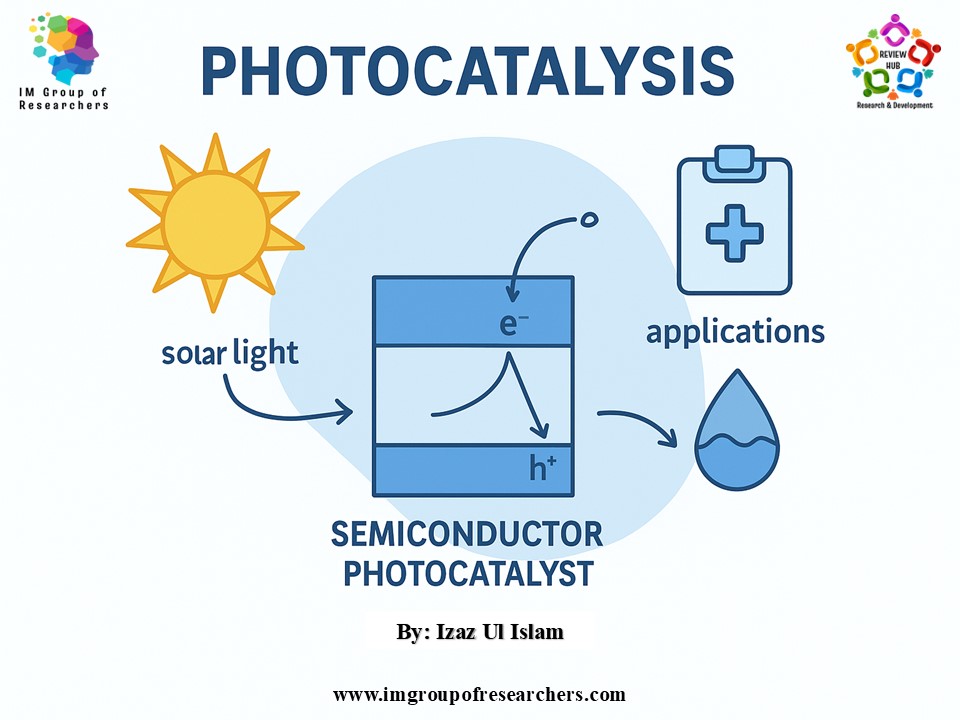Author: Izaz Ul Islam
College of Chemistry and Molecular Sciences, Henan University China
Introduction
Photocatalysis is central to sustainable energy, environmental remediation, and green chemistry. Despite decades of work, many aspects of photocatalysis remain debated or poorly understood. In his critical review “Photocatalysis A to Z”, Prof. Bunsho Ohtani systematically analyzed fundamental concepts — from activity and band structure to Z-scheme photocatalysis — clarifying what is established knowledge and what remains unresolved. Here we present a concise but detailed overview tailored for graduate students and early-career researchers.
Key Concepts and Insights
1. Photocatalytic Activity
The commonly used term photocatalytic activity generally refers to the reaction rate under illumination. However, unlike thermal catalysis where active sites dictate activity, photocatalysis depends on light absorption, electron-hole generation, and recombination kinetics. The intrinsic activity constant remains elusive due to difficulties in measuring recombination rate directly.
Known: Relative activity under controlled conditions.
Unknown: Intrinsic activity constant and absolute kinetic models.
2. Band Structure
Semiconductors absorb photons to promote electrons from the valence band (VB) to the conduction band (CB), creating electron-hole pairs. However, the spatial dynamics of these carriers — whether they immediately localize in traps or remain delocalized — are not fully understood. Misconceptions persist that electrons “migrate” spatially across bands, rather than being excited states of the lattice.
Known: CB and VB positions, band gaps.
Unknown: True nature of initial photoexcited states and carrier migration mechanisms.
3. Crystallinity and Defects
Crystallinity influences photocatalytic efficiency, yet quantification remains difficult. XRD identifies crystalline phases but ignores amorphous content. Sharp XRD peaks are often misinterpreted as higher crystallinity when they may simply reflect particle size.
Known: Relative crystal growth and phase composition.
Unknown: Precise quantification of amorphous content and defect distribution.
4. Doping and Visible-Light Activation
Non-metal (e.g., N, S) or metal doping extends absorption into visible light. Yet, “doping” is often mischaracterized; true lattice incorporation is rarely confirmed, and many systems merely involve surface modification or sensitizer deposition. Verification requires correlation of absorption spectra with action spectra.
Known: Doped/modified catalysts can exhibit visible-light activity.
Unknown: Precise location, distribution, and mechanism of dopant-induced states.
5. Energy Conversion and Thermodynamics
Water splitting remains the benchmark reaction. Efficiency depends not only on quantum yield but also on Gibbs free energy considerations. Even if short-wavelength photons are absorbed, excess energy above the CB edge is lost as heat. Thus, extending absorption to longer wavelengths is crucial, but improving conversion efficiency in shorter-wavelength regimes is equally important.
Known: Requirements for band edge alignment with redox potentials.
Unknown: Optimal calculation methods for biased systems and practical routes to reduce energy losses.
6. Reaction Kinetics
Many photocatalytic reactions exhibit apparent first-order kinetics or fit Langmuir–Hinshelwood models. However, these are formal correlations and do not necessarily reveal the underlying mechanism. Kinetic constants derived from light-intensity-limited conditions often obscure adsorption–reaction interplay.
Known: Methods for kinetic fitting.
Unknown: True mechanistic steps and universal rate-determining factors.
7. Carrier Recombination
Electron–hole recombination drastically reduces efficiency, but direct quantification remains challenging as recombination does not yield measurable species. Advanced ultrafast spectroscopy has provided indirect insights, yet bridging these dynamics to practical reaction rates is unresolved.
8. Identification of Products
Product identification is often overlooked. Chromatography alone may mislead; rigorous confirmation (e.g., NMR, MS) is essential, especially for complex organic transformations.
Known: Analytical methods exist.
Unknown: Achieving “sufficient condition” proof in strict chemical sense.
9. Z-Scheme Photocatalysis
Inspired by natural photosynthesis, Z-schemes couple two photocatalysts to achieve overall water splitting. Despite progress, the stability of interfacial electron transfer and efficiency bottlenecks remain significant challenges.
Conclusion
Photocatalysis sits at the frontier of energy and environmental science. What we know is foundational: band structures, empirical activities, and thermodynamic requirements. What we do not know — carrier localization, recombination dynamics, defect roles, and reliable product identification — remains a barrier to rational design. For graduate researchers, the challenge is not only to optimize materials but to critically evaluate assumptions, ensuring progress moves from empirical discovery toward predictive science.
Reference: Ohtani, B., 2010. Photocatalysis A to Z—What we know and what we do not know in a scientific sense. Journal of Photochemistry and Photobiology C: Photochemistry Reviews, 11(4), pp.157-178.
Read More: How To Write A Research Proposal?
Follow Us on

